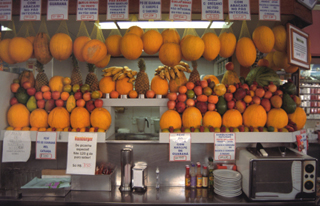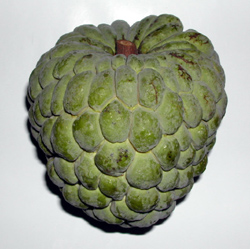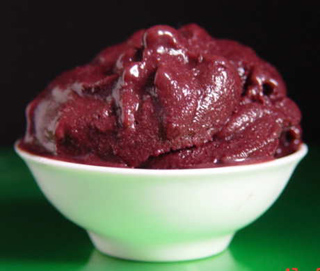Rio Fruits & Juices – A Basic Guide
In Rio fruits and juices are really something. The tropical rainforests around Brazil has created a multitude that is clearly visible in your corner juice bar. I will start with describing some fruits that you know and some you probably don’t. I do not describe them all since the list never would end. The Portuguese name is in parenthesis if it’s different than the English.
Rio Fruits
Banana Various types are available. Cooking bananas (plantanas) is called banana da terra and the sweet ones we eat banana prata. Also you have the small and very sweet banana de ouro. The taste and quality is in general very good.
Orange (laranja) Many varieties exists. The laranja Bahia, laranja seleta or laranja da pera are sweeter and is used for juices or just to eat. Stay away from laranja lima since the taste is not good. In general the oranges in Rio are not so good. You can find sweet ones but what’s sold in the supermarkets is of very uneven quality so you really have to know how to pick them out. On the open air fruit markets you can get really nice ones.
Lime (limão) Not native to Brazil (none of the citrical fruits are) but very popular. Used in sweets, food and drinks.
Lemon (limão siciliano) This is the lemon you have in Europe and North America. Not so common.
Pineapple (abacaxí) One of the highlights here. You should be able to buy really sweet and savoury ones, they should smell as you want them to taste.
Plum (ameixa) As with many fruits better in the colder parts of the country.
Custard apple (fruta de conde) Looks like a green handgranade and the taste is actually a little bit like custard. Try it!
Watermelon (melancía) Another good fruit to buy here. The more hollow it sounds, the more mature and sweet it is.
Tangerine (tangerina) They are nicely sweet and conveniently big.
Apple (maçã) Quite expensive and during summer not often that good because of the climate. Better in the South of Brazil.
Pear (pera) Same as with the apple above.
Passionfruit (maracujá) In Rio you get the big yellow kind, the purple smaller you find in the south of the country. This is truly a great fruit to buy here. Shake them to see if they are ripe, you should feel the inside moving around a bit, not too much though.
Mango (manga) Here you have many varieties. The most well tasting ones I find is haden. They should have a significant smell of mango and not be hard. The small espada variety is nice to have as a small snack.
Papaya (mamão) In Brazil the papaya we know is called mamão papaya. The other varieties, like the large mamão formosa, is different in taste and texture but still good to eat. Very good quality in general, make sure they are not too hard or too soft.
Avocado (abacate) The species we know from Europe, Mexico and North America is called abacate avocado and is only available certain parts of the year. The abacate is a lot less low on fat and used for making shakes (mixed with sugar and milk). It is not as suitable for guacamole or other dishes that are made with the other variety.
Persemon (caqui) This fruit of Japanese origin is available for some really decent prices certain parts of the year. Delicious when eaten cold and ripe.
Acerola Small cherry looking fruit. Very sour and really rich on vitamin C. Mixed in orange juice it is a treat!
Cashew (caju) The fruit is good in juices and in desserts, not on it’s own so much.
Guava (goiaba) The goiaba vermelho is another of the Rio fruits that has a taste on its own. Good in juice or just to eat.
Taggannona (graviola) This a sweet fruit that has a very distinct taste. Has medicinal qualities and has long been used in nature medicine. Best appreciated as a juice since it has many seeds.
Cupuaçu Another unique rainforest fruit. Its white meat is delicious in juice form. Common in sweets as well.
Coconut (coco) Although they sell the older dried coconut with its thick white meat it’s the fresh green coconut you see everywhere. Many Cariocas start their day with a cold green coconut on the beach.
Açaí This little fruit grows is from a palm tree. In Rio its frozen pulp is mixed with guaraná syryp and served like a sherbet. Aside from being delicious it’s very healthy.
Juices and Fruit Drinks
Since most stuff is not grown in the state of Rio fruits for juices are not always fresh. Instead they use frozen pulp as is the case with açaí. These juices and fruit drinks are available at most juice bars, important is to find a good one. Don’t go after the price, my experience is that some of the cheaper places actually have better juices, maybe because they have a bigger flux of clients. Big Nectar has a chain of juice bars, I always found them a safe bet. Remember to ask for less sugar (pouco açucar) or no sugar (sem açucar). This is just a selection of juices and drinks I think is worth trying out.
– Suco da Laranja com Acerola High on vitamin C, needs sugar
– Suco de Graviola Yummy and healthy, ask for little sugar
– Suco de Cupuçu Lots of vitamins, little sugar needed
– Vitamina de Abacate The Brazilian avocado mixed with sugar and milk, delicious!
– Suco de Abacaxi com Hortelã Pineapple mixed with mint leaves, no sugar please.
– Caldo de Cana Sugarcane juice. Very sweet but delicious, an energy boost!
– Refresco de Caju Is already mixed so it can be very sweet.
– Refresco de Guaraná Guaraná is a little berry with a high content of e caffeine like substance. Energy!
– Açaí Is best in its sherbet form. You have to experiment to find your preference. Can be served with müsli, banana or strawberry. Is always mixed with sweet guaraná syryp. What’s sold on the beach is often not that good.
Perhaps you want to read more about fruits in general? Click this link and you will come to my food site and a list of fruits.







